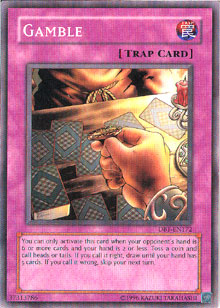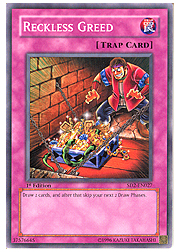 This week’s article is a "sequel" to my last "getting back in the game" article written a few weeks ago. Last time, I assumed you still had your collection and were just taking some time off from the game. But what if you don’t have your collection anymore? Often, players who take time off from the game tend to sell their cards to the highest bidder (or as they say in casino lingo, "cash in their chips"). They do this to either make a quick buck with the intention of never playing again, or simply give their collection to someone else (this is rare). If you’re one of those duelists who has disposed of his or her collection for whatever reason and are interested in playing again, then this article is definitely for you. Let’s begin.
This week’s article is a "sequel" to my last "getting back in the game" article written a few weeks ago. Last time, I assumed you still had your collection and were just taking some time off from the game. But what if you don’t have your collection anymore? Often, players who take time off from the game tend to sell their cards to the highest bidder (or as they say in casino lingo, "cash in their chips"). They do this to either make a quick buck with the intention of never playing again, or simply give their collection to someone else (this is rare). If you’re one of those duelists who has disposed of his or her collection for whatever reason and are interested in playing again, then this article is definitely for you. Let’s begin.
Where Do I Start?
Assuming you’re starting from zero and if you’ve read my previous article about catching up with the game again, then you’re probably wondering how on earth you’ll get your hands on some of the cards that the Day 2 decks have, right? Fortunately, most of the cards are very affordable. The first place to look for what you need is the "secondary market," also known as eBay. On eBay you’ll often find cheaper prices than what you’ll find in retail. If you haven’t already created an eBay account then I suggest you register and sign up for Paypal as well. Keep in mind that you can buy exclusively from eBay or you can buy at retail stores like Wal-Mart, Target, or your local card shop. (Jason’s Note: Remember, if you’re under 18 be sure to get the go-ahead from your parents before signing up for any of these sites.)
On the other hand, what if you don’t have much cash to spend on cards? Don’t worry, there’s another way. First you get in touch with one of your former dueling buddies, and ask to borrow cards for a deck. If your friends object, then ask if you can simply borrow a deck for just the local tournament and promise to return the cards when it’s over. Why would you do this? One of the best ways to earn the maximum return for your investment is to start winning local tournaments. A paltry five-dollar entry fee for three to five packs is exceptional and if repeated week after week will prove to be very profitable for you. If your store offers credit, that’s another good way to buy key singles you need. Simply save up the store credit for a few weeks and cash in. If you’re very good, you can exchange your saved credit at the end of every month for a hefty payoff.
If you’re going to borrow from your old friends or new ones, make sure that you’re trustworthy in their view. They need to know you’re good for it. Trust me when I say that they will judge this by their own criteria. Here are some criteria I personally look for before I lend cards (if ever). (1) What condition are this player’s current cards in? Has he or she borrowed cards from someone else before and left them intact? (2) How likely is it that this player will "forget" to return my cards? (3) Is he or she reliable? Can I trust him or her, even for a few hours? (4) What is this player’s reputation? What is he or she known for? What do I know him or her for? (5) Is this player asking politely or simply demanding cards?
Establishing a good reputation for borrowing is very important when you’re low on cash, and it is absolutely critical that you never forget to return cards that you borrow. Write it down if you have to. Set a reminder up on your cell phone, or whatever you need to do. Once you’ve lost your credibility then you’ll slow your progress and will have to rely on chore money, whatever is left over from your paycheck, or worse . . . not get to play at all due to lack of available cards.
Your Game Plan: The Competitive Side
Now that you’ve identified places where you can get cards, you need a good game plan to follow in order to eventually obtain your own cards. There is more than one way to do this so I’ll try to give you some pointers on how to maximize the number of cards you get.
 First, make sure you have that eBay account I talked about earlier. You’re going to need it. After you’ve done that, get a hold of the latest major tournament results, which you can find on here on Metagame.com in the Events Archive. Next, you have two choices: (1) you can play-test online or (2) you can test like you normally would, but with proxies. I highly recommend playing with proxies, especially when you’re playing "on the cheap." I can’t tell you how invaluable it is to be able to test with complete decks before actually owning the cards. If you’re worried about your testing partners, rest assured that everyone knows what proxies are and they’d be more than happy to run a few test matches with you—even without real cards. Making proxies requires three things: paper, a pencil or a pen, and extra commons. If you want to keep it simple and quick, you can use a Sharpie and some extra commons instead, writing directly on them. Once you’ve got your slips of paper, just sleeve them in front of the commons and you’re ready to go. The next step is to test, test, and test some more to find out which strategies are the strongest and what counter-measures are needed. Staying in touch with the metagame is vital.
First, make sure you have that eBay account I talked about earlier. You’re going to need it. After you’ve done that, get a hold of the latest major tournament results, which you can find on here on Metagame.com in the Events Archive. Next, you have two choices: (1) you can play-test online or (2) you can test like you normally would, but with proxies. I highly recommend playing with proxies, especially when you’re playing "on the cheap." I can’t tell you how invaluable it is to be able to test with complete decks before actually owning the cards. If you’re worried about your testing partners, rest assured that everyone knows what proxies are and they’d be more than happy to run a few test matches with you—even without real cards. Making proxies requires three things: paper, a pencil or a pen, and extra commons. If you want to keep it simple and quick, you can use a Sharpie and some extra commons instead, writing directly on them. Once you’ve got your slips of paper, just sleeve them in front of the commons and you’re ready to go. The next step is to test, test, and test some more to find out which strategies are the strongest and what counter-measures are needed. Staying in touch with the metagame is vital.
Once you’ve done enough testing and you’re confident about your odds of winning, then you need to find out where the nearest card shops are that hold tournaments. You’re going to hit the local tournament scene first. The best way to do this is by using the Local Tournament Locator. Once you’ve scoped out the local shops available to you, then you need to visit them or phone them (use Google Maps for directions) and inquire about their tournament schedules. You should know that there are local stores that hold tournaments during the week as well. These are often the best to go to if you can get enough players to participate.
Try to get a good balance of local stores that hold weekday tournaments and stores that hold weekend tournaments exclusively. Local tournament entry fees are typically about five dollars per entrant, depending on the number of competitors and the prize structure. Prize structure is very important when it comes to selecting the right stores to play at, as is the level of competition. You don’t want to waste your time with stores that don’t offer at least fifteen to twenty dollars worth of return for your investment and time. That price range is about three to five packs for your entry fee (assuming a five-dollar entry fee).
Start with the stores where the level of competition isn’t as difficult. You can compete there with little trouble and start to build a feel for your area’s metagame in the process. Stores with lower levels of competition typically have a smaller customer base. Once store owners see that you’re starting to frequent their establishment and bringing your friends along with you, then they’ll be prompted to increase their prize support for the new influx of weekly participants: a mutually beneficial relationship. All you have to do is ask. Schedule your tournaments back-to-back if you can. For example, a few years ago when I lived in south Florida I would go to one tournament that lasted from 12:00PM to 3:00PM and then hit the 4:00PM tournament at my home store, all on a Saturday. Then I would visit my home store again on Sunday for another tournament. You’re not going to get very far on just one tournament a week. You’ve got to hit at least two or three each week to get any real return.
Now, what do with your winnings? You have a few options here which I’ll list briefly. (1) Sell your winnings to get cash, either online or to other players in your area, reinvesting in your collection. (2) Trade your good singles for better singles. (3) Use your store credit to buy singles, packs, or boxes of boosters. (4) Keep a portion of your winnings for your personal collection.
Final Thoughts
All the prep work to start building your card collection is a bit time-consuming, but it’s free of charge. All the tools and services I’ve referred you to are great places to start building your skill to execute your plan of action. Once you get on a roll, you can start buying the cards you need for the tournaments you attend. Because of space constraints I won’t be able to explain how to manage and amass your collection as you move forward with your plan. I’ve simply given you a starting point. This is the method I used to build my collection minus a few online services. I started with the local tournaments upward to the Regional Qualifiers and Shonen Jump Championships.
Next week, I’ll go into more detail about how to maintain your growing collection—including trading strategies, keeping your cards in good condition, finding places to keep it, using borrowing to mutual advantage, and even a few tips on how to grow a collection using a group. Also, we can take a look at this from the judging angle and see how to use the prime judging "gigs" to get a potentially higher return for your time.
Until next week, make sure to stay focused and have fun! Good luck!